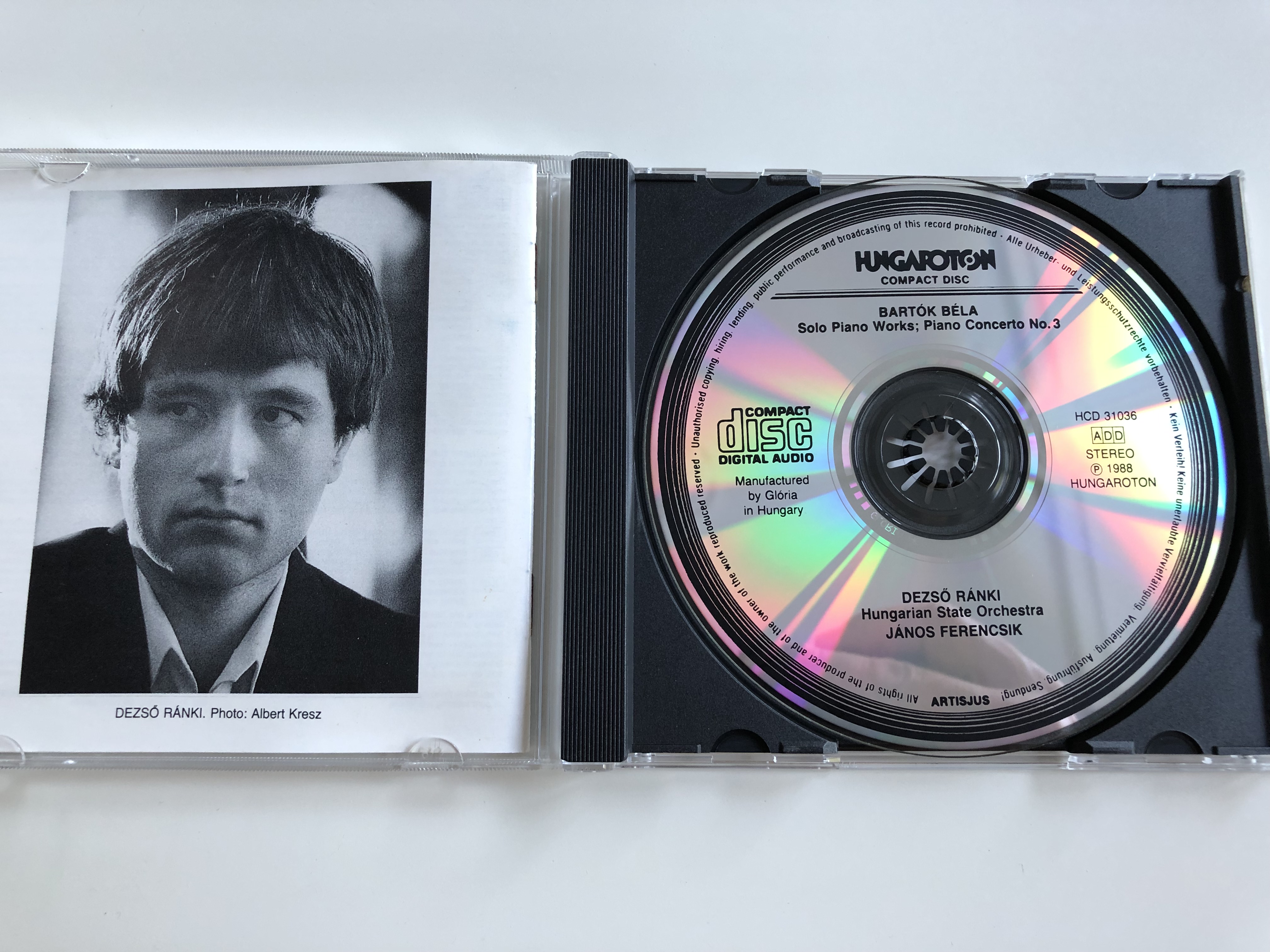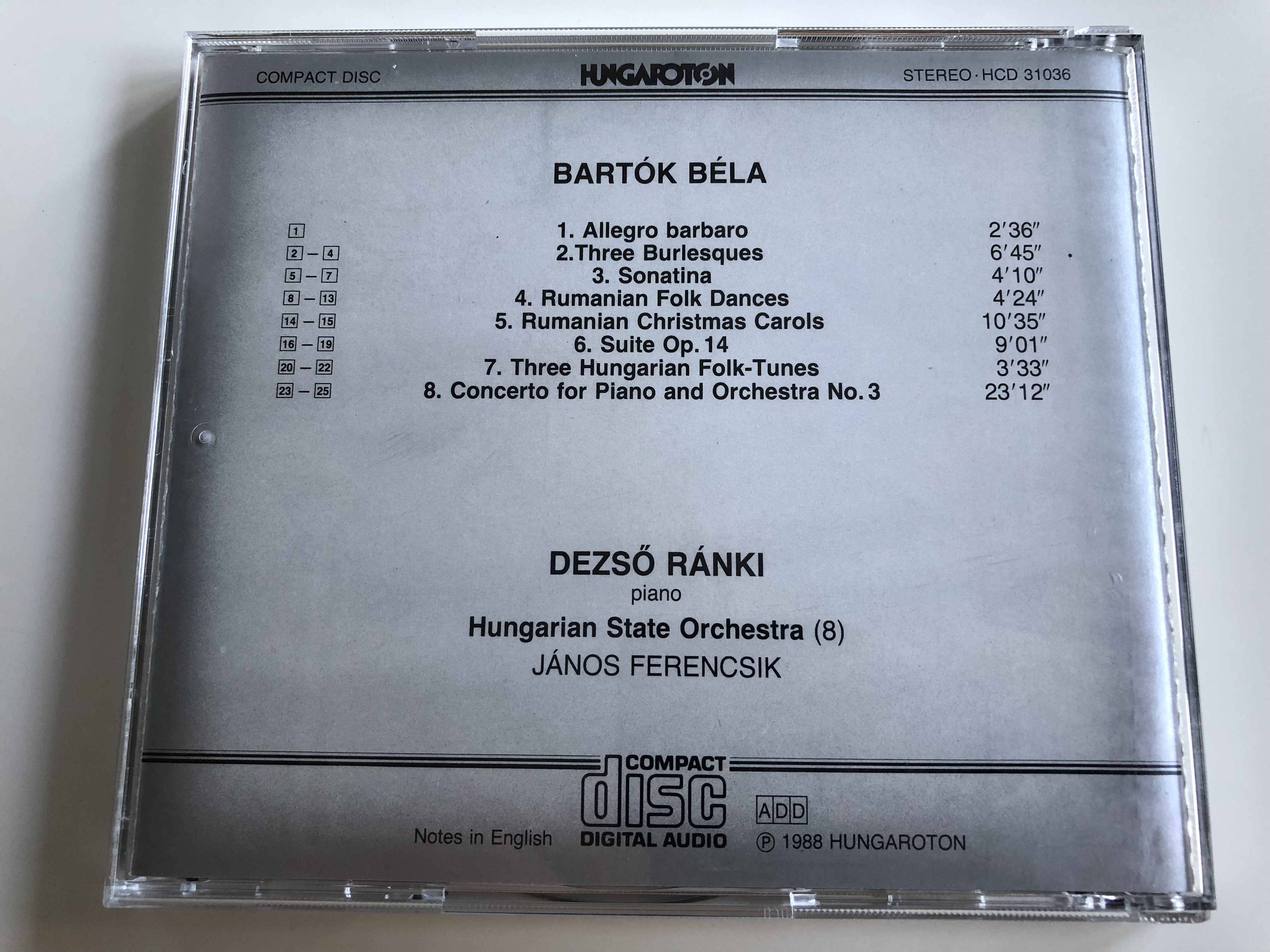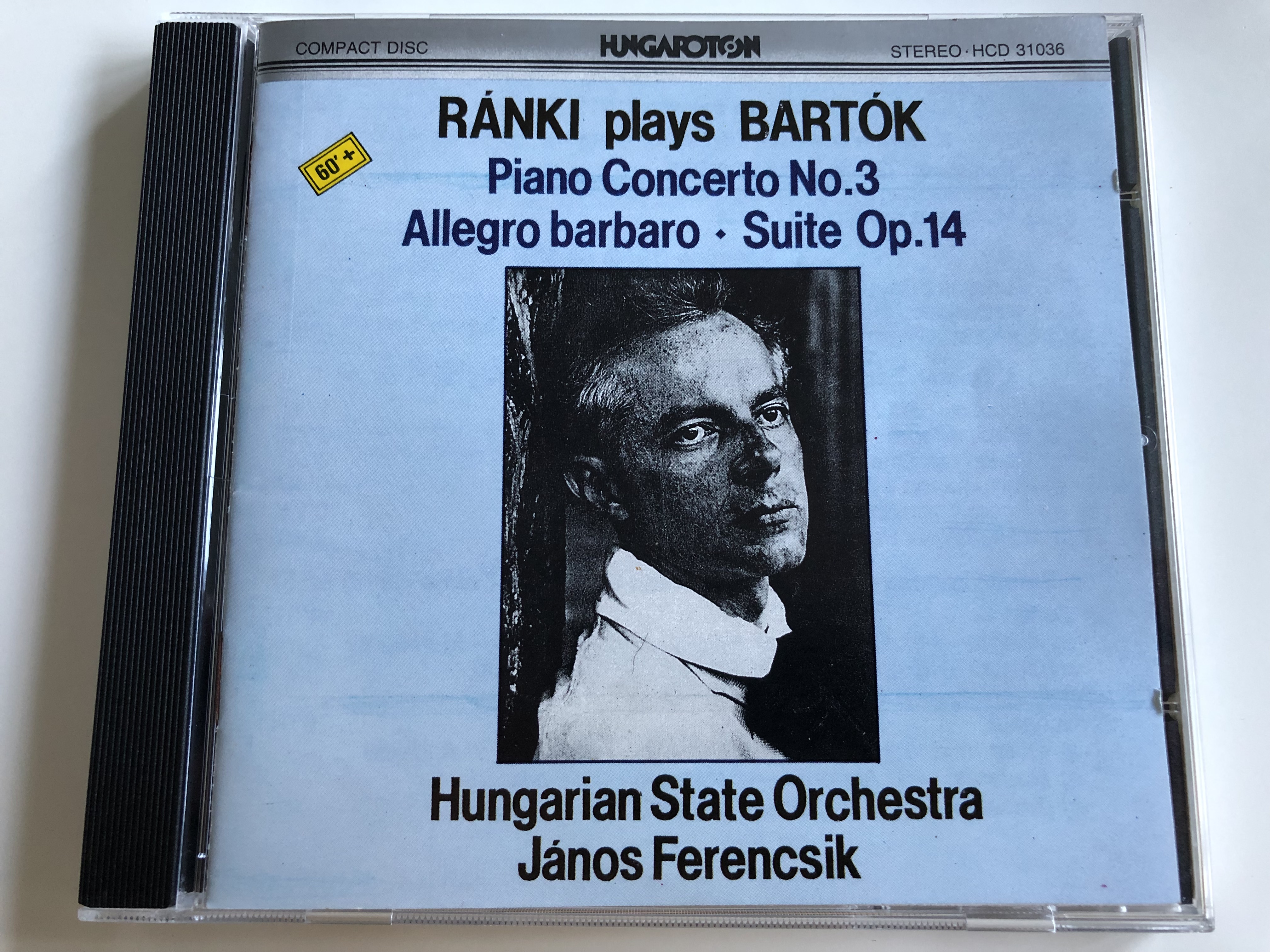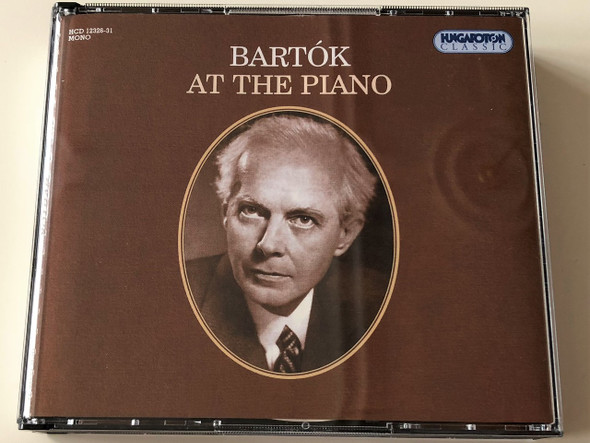Description
Ránki Plays Bartók – A Masterful Interpretation of Bartók’s Works (Audio CD)
Product Details
- Product ID: HCD31036
- Label: Hungaroton – Audio CD (1988)
- Format: Audio CD, Album
- Country: Hungary
- Release Year: 1988
- Ensemble: Hungarian State Orchestra
- Conductor: János Ferencsik
- Pianist: Dezső Ránki
- Producer: András Székely
- Engineers: László Csintalan, István Berényi
- Liner Notes: László Somfai, János Kovács
- Photography: Albert Kresz
Overview
English
"Ránki Plays Bartók" presents an exceptional audio journey through some of Béla Bartók’s most compelling works. This 1988 Hungaroton Audio CD features the brilliant pianist Dezső Ránki accompanied by the Hungarian State Orchestra under the baton of János Ferencsik. The album encompasses a wide-ranging program that includes:
- Piano Concerto No. 3 (1945) – A powerful work in three movements (Allegretto, Adagio religioso, Allegro vivace) that showcases Bartók’s mature orchestral writing.
- Allegro Barbaro (1911) Sz.49 – A percussive, primitive, yet dynamically captivating piece.
- Suite Op. 14 (1916) – A multi-movement suite that highlights Bartók’s innovative textures and rhythmic energy.
- Various arrangements and transcriptions including burlesques, folk dances, and Christmas carols, which echo Bartók’s deep engagement with folk traditions.
This recording captures not only the technical brilliance and emotional depth of Bartók’s compositions but also the refined interpretative power of Dezső Ránki and the Hungarian State Orchestra.
Magyar
A "Ránki Plays Bartók" című felvétel kivételes zenei utazást kínál Bartók Béla legizgalmasabb művei között. A 1988-as Hungaroton Audio CD Dezső Ránki zongorajátékával, a Magyar Állami Zenekar előadásában, János Ferencsik karmester vezetésével bemutat egy gazdag programot, mely tartalmazza:
- Zongoraverseny No. 3 (1945) – Három tételben kidolgozott, erőteljes mű, amely bemutatja Bartók érett zenekari írásművészetét.
- Allegro Barbaro (1911) Sz.49 – Ritmikus, nyers és dinamikus erővel rendelkező darab.
- Suite Op. 14 (1916) – Több tételes válogatás, mely Bartók innovatív textúráit és ritmikus lendületét emeli ki.
- Különféle átírások és feldolgozások, mint például burleszkek, román népi táncok, karácsonyi dallamok, amelyek tükrözik Bartók mély kapcsolatát a népzenei hagyományokkal.
Ez a felvétel nem csupán Bartók műveinek technikai és érzelmi mélységét, hanem Dezső Ránki és a Magyar Állami Zenekar kifinomult előadói képességét is megmutatja.
Product Features
-
Diverse Program:
The album presents a rich juxtaposition of Bartók’s diverse compositional styles—from the raw energy of Allegro Barbaro to the intricate textures of the Piano Concerto and Suite Op. 14. -
Elite Performance:
Dezső Ránki’s virtuosic piano playing, combined with the expressive sound of the Hungarian State Orchestra under János Ferencsik, delivers a performance of exceptional artistry. -
Historical Significance:
This recording from 1988 is a landmark document capturing Bartók’s mature works alongside his innovative reworkings of folk material, reflecting both modernist aesthetics and deep national roots. -
High-Fidelity Sound:
The engineering work of László Csintalan and István Berényi ensures clarity and precision, bringing out every nuance of the performance.
Long-tail keywords: Bartók Piano Concerto No.3 CD, Dezső Ránki Hungarian State Orchestra, Allegro Barbaro recording, Bartók Suite Op.14 album, 20th-century classical CD, Hungaroton Bartók performance
Interesting Facts
-
A Comprehensive Bartók Experience:
The CD features a multifaceted program that not only highlights Bartók’s orchestral grandeur in his Piano Concerto No. 3 and Suite Op. 14 but also delves into his explorations of folk elements through pieces like Allegro Barbaro and various folk-inspired arrangements. -
Masterful Collaboration:
The synergy between pianist Dezső Ránki and the Hungarian State Orchestra, under the insightful direction of János Ferencsik, is a testament to the enduring legacy of Hungarian musical tradition. -
Innovative Folk Interpretations:
Bartók’s ability to transform folk tunes into sophisticated concert pieces is evident in the inclusion of burlesques, folk dances, and Christmas carols, making this album not just a display of virtuosity but also a cultural document. -
Critical Acclaim:
Liner notes by esteemed critics László Somfai and János Kovács provide deeper insight into the interpretation and significance of these works, enriching the listener’s experience.
Magyar – Érdekességek:
- Átfogó Bartók-élmény:
A CD olyan programot kínál, amely bemutatja Bartók zenekari felfogását a Zongoraverseny és a Suite Op. 14 révén, miközben felfedi a népi elemek feldolgozásának újszerűségét az Allegro Barbaro és egyéb átírásokon keresztül. - Mestermű együttműködés:
A Dezső Ránki és a Magyar Állami Zenekar, János Ferencsik vezetésével elért összhang a magyar zenei hagyományok maradandó örökségét dicséri. - Innovatív népi feldolgozások:
Bartók képes volt a népdalt magas szintű, koncertre méltó művé alakítani, amit a burleszkek, román népi táncok és karácsonyi dallamok is bizonyítanak. - Kritikai elismerés:
A Liner Notes (László Somfai, János Kovács) hozzájárulnak a mű mélyebb megértéséhez, gazdagítva ezzel a hallgatói élményt.
Track Listing
The program is divided into several sections showcasing different facets of Bartók’s work:
Section 1: Early 20th-Century Miniatures
- Allegro Barbaro (1911) Sz.49 – Explosive and percussive, typically lasting around 2:36 to 2:40.
- Három Burleszk (Three Burlesques) Op. 8c Sz.47 – An entertaining suite divided into three parts, with movements such as "Perpatvar" (Presto), "Kicsit ázottan" (Allegretto), and "Molto vivo capriccioso."
Section 2: Sonatina and Folk Dances
- Sonatina (1915) Sz.55 – Including movements like "Dudások" (Bagpipers), "Medvetánc" (Bear Dance), and "Finale. Allegro vivace."
- Román Népi Táncok (Rumanian Folk Dances) (1915) Sz.56 – Comprising various brief dances such as "Jocul cu bâtâ" (Stick Dance), "Brâul," "Pe loc," "Buciumeana," "Poarga românească," and "Mănunțelul."
- Román Kolinda-Dallamok (Rumanian Christmas Carols) (1915) Sz.57 – Featuring two series that capture the festive spirit of regional caroling.
Section 3: Suite Op. 14 (1916) Sz.62
- A four-movement suite that displays the composer’s refined inner voice through movements titled "Allegretto," "Scherzo," "Allegro molto," and "Sostenuto."
Section 4: Three Hungarian Folk-Tunes (1914–1918) Sz.66
- Three distinct folk-inspired pieces including "Leszállott a páva" (The Peacock), "Jánoshidi vásárban" (At the Jánoshida Fairground), and "Fehér liliomszál" (White Lily).
Section 5: Piano Concerto No. 3 (1945) Sz.119
- A three-movement concerto comprising:
- I. Allegretto – A vibrant start (approx. 7:11).
- II. Adagio religioso – A deeply spiritual, lyrical middle (approx. 9:36).
- III. Allegro vivace – A brisk and spirited finale (approx. 6:25).
Note: Track timings vary slightly between printed versions but remain faithful to the overall structure.
Publishers
Released by Hungaroton, this landmark Audio CD from 1988 encapsulates the innovative spirit of Bartók’s compositions as interpreted by renowned artist Dezső Ránki and the Hungarian State Orchestra. This recording remains a cherished reference for classical music enthusiasts and scholars alike, reflecting both historical significance and artistic excellence in 20th-century music.
We value your feedback! Share your experience with this product to help others make informed decisions. Your review is important to us!
Hashtags
English:
#RánkiPlaysBartók #BartokPianoConcerto3 #AllegroBarbaro #SuiteOp14 #HungarotonCD #HungarianStateOrchestra #DezsoRanki #JanosFerencsik #ModernClassical #20thCenturyMusic
Hungarian:
#RánkiPlaysBartók #BartókZongoraverseny3 #AllegroBarbaro #SuiteOp14 #Hungaroton #MagyarÁllamiZenekar #DezsőRánki #JánosFerencsik #XXSzázadiZene #ModernKlasszikus






























